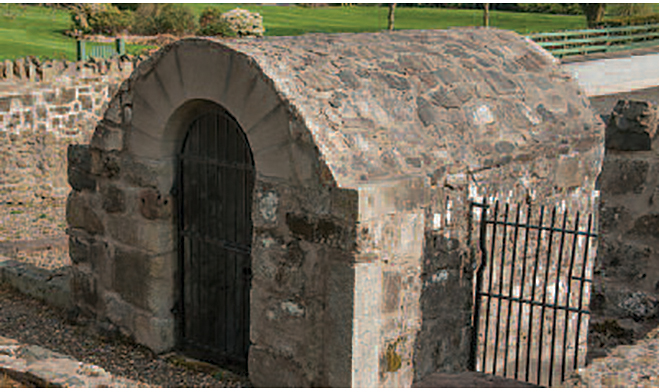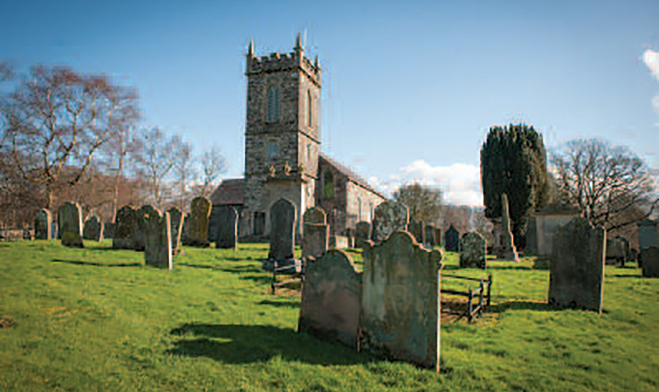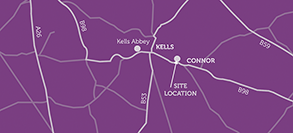Pre-Reformation Trail
St Saviour's Connor
All the other churches yielded in importance to Connor
Access details
St Saviour's churchyard is located off Church Road, Kells. The churchyard is accessible during the hours of daylight. The ruins of Kells Abbey are not publicly accessible as they are located on private ground. However, they can be viewed from the Greenfield Road, Kells.RPC
Grid Reference
The founding of the monastery
Aengus, or ‘Mac Nissi’ as he was known, founded the monastery of Connor around AD 480. Mac Nissi, it has been claimed, was baptised by St Patrick and joined him in the singing of the Psalms.
Early history
The importance of the monastery of Connor is such that Diarmaid, son of the King of Ireland was buried there. In 612 the monastery was burned and in 832 it was plundered by Vikings. The Viking attack on the monastery points to its ecclesiastical and civic importance. A souterrain (underground man made chamber) was discovered at Connor. They were used as a place of refuge and hiding during attack. Connor also at one time had a round tower.
A fragment of Connor's high cross dating to around the 800s survives in the present church. A tomb stone with a Latin inscription, now in the Ulster Museum, is thought to relate to the monastery of Connor or the abbey at Kells. Two bullaun stones are located at the entrance to the present church.
By the early 1100s, the authority of the Bishop of Connor stretched as far as Coleraine and included the present dioceses of Down and Dromore. This was a time of major reform in the Irish church. Restructuring took place to bring the Irish church into the Roman church system. Due to these reforms, the offices of bishop and abbot of Connor which had previously been held by the same person, were separated.
Edward Bruce and the Battle of Connor
In 1315 the Anglo-Norman army of Richard de Burgh was drawn into battle at Connor with the invading Scottish army of Edward Bruce. Following the battle, the settlement of Connor never recovered its previous status as a prominent centre in mid Antrim. Bruce’s victory left him as the effective master of Ulster until his death in battle in 1318.
The 1600s
The church at Connor was constituted as a cathedral of the Church of Ireland by James I in the early 1600s. However, by 1622 the church was in a state of decay. It was damaged in the 1641 rising and was no longer in repair by 1657. In 1662 the church at Lisburn was designated the Cathedral of Connor Diocese as it remains today. Connor was then reduced to being a parish church.
1700s – 1900s
By 1768, the church at Connor was in a very bad condition. In the 1810s, a new church was built on the site of the old and it is still in use today. The grounds of the churchyard contain a ‘corpse house’ that was used in the 1800s for the safekeeping of bodies before burial. During the late 1800s there were concerns about overcrowding of the graveyard. Despite much local resistance the graveyard was eventually closed.
The fort of Connor
The fort of Connor is located close to the entrance of the former rectory. It is believed to have been the residence of the bishops of Connor. It is thought to have been built between the mid 1100s and the Battle of Connor in 1315. The site was later occupied by a building which served as the session house and school house of Connor Presbyterian Church.
The graveyard
In 1835 it was noted that: ‘Roman Catholics do not or are not allowed to bury in the churchyard.’ In fact, the Catholic community used the burial ground at Nearby Templemoyle in Kells.
As with other graveyards, the tombstone inscriptions at Connor indicate emigration destinations of some of those who are buried there. Occupations of those who died far from home include military personnel as recorded on the Gardener and Johnston memorials. There is also a memorial for Jesse Millar who was lost on his ship Crimea in a 'terrific storm' on the Black Sea in November 1873.
Robert Aiton
Robert Aiton's tomb was built on a fragment of the ancient cathedral. Locally, he was thought a good man and held in high regard by the local villagers. He planted trees, built a bridge and a wall around the ancient ruin. He died in 1663, aged 80. So much was thought of him, that it was written that his tomb would never come to ruin. However, his memorial is no longer visible.
Dinsmore family
Several gravestones in the graveyard remember the Dinsmore family. There is also a family memorial font and baptistery inside the church. One of the memorials is to Francis Dinsmore, who died in 1864 aged 79. Francis took over the running of Old Green Woollen Mill at Kells after his father. He expanded the mill to include the dyeing and finishing of fabric.
Francis Dinsmore’s son John later inherited the mill from his father, and updated it with advanced machinery. As well as being a pioneer for the development of woollen manufacture in mid-Antrim, John was a Liberal district councillor and outspoken critic of Unionism around the time of the Home Rule Crisis. He believed that the best compromise would be to allow Irish Home Rule to pass but to exclude the north-east.
Moore family
A gravestone marks the family plot of brothers, John H and Samuel J Moore who were both passionately involved in the spiritual revival which sprang from Connor and Kells in 1859.
| Churchyard Facts & Figures | |
| First used as a Christian religious site | c. 480AD |
| Papal taxation of c.1300 | 1 mark |
| Church name used in Papal taxation c. 1300 | Coneria |
| Replaced by | New church on site, built 1811-13 |
| Townland | Connor |




